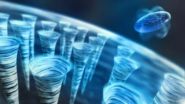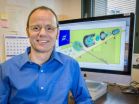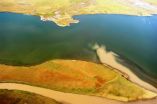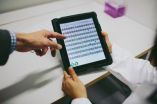(Press-News.org) The severe drought gripping the western United States in recent years is changing the landscape well beyond localized effects of water restrictions and browning lawns. Scientists at Scripps Institution of Oceanography at UC San Diego have now discovered that the growing, broad-scale loss of water is causing the entire western U.S. to rise up like an uncoiled spring.
Investigating ground positioning data from GPS stations throughout the west, Scripps researchers Adrian Borsa, Duncan Agnew, and Dan Cayan found that the water shortage is causing an "uplift" effect up to 15 millimeters (more than half an inch) in California's mountains and on average four millimeters (0.15 of an inch) across the west. From the GPS data, they estimate the water deficit at nearly 240 gigatons (62 trillion gallons of water), equivalent to a six-inch layer of water spread out over the entire western U.S.
Results of the study, which was supported by the U.S. Geological Survey (USGS), appear in the August 21 online edition of the journal Science.
While poring through various sets of data of ground positions from highly precise GPS stations within the National Science Foundation's Plate Boundary Observatory and other networks, Borsa, a Scripps assistant research geophysicist, kept noticing the same pattern over the 2003-2014 period: All of the stations moved upwards in the most recent years, coinciding with the timing of the current drought.
Agnew, a Scripps Oceanography geophysics professor who specializes in studying earthquakes and their impact on shaping the earth's crust, says the GPS data can only be explained by rapid uplift of the tectonic plate upon which the western U.S. rests (Agnew cautions that the uplift has virtually no effect on the San Andreas fault and therefore does not increase the risk of earthquakes).
For Cayan, a research meteorologist with Scripps and USGS, the results paint a new picture of the dire hydrological state of the west.
"These results quantify the amount of water mass lost in the past few years," said Cayan. "It also represents a powerful new way to track water resources over a very large landscape. We can home in on the Sierra Nevada mountains and critical California snowpack. These results demonstrate that this technique can be used to study changes in fresh water stocks in other regions around the world, if they have a network of GPS sensors."
INFORMATION:
The study was supported by USGS National Earthquake Hazards Reduction Program.
Severe drought is causing the western US to rise
Scientists use GPS technology to track uplift from recent massive loss of water, estimated at 62 trillion gallons
2014-08-21
ELSE PRESS RELEASES FROM THIS DATE:
X-ray laser probes tiny quantum tornadoes in superfluid droplets
2014-08-21
An experiment at the Department of Energy's SLAC National Accelerator Laboratory revealed a well-organized 3-D grid of quantum "tornadoes" inside microscopic droplets of supercooled liquid helium – the first time this formation has been seen at such a tiny scale.
The findings by an international research team provide new insight on the strange nanoscale traits of a so-called "superfluid" state of liquid helium. When chilled to extremes, liquid helium behaves according to the rules of quantum mechanics that apply to matter at the smallest scales and defy the laws of classical ...
Researchers map quantum vortices inside superfluid helium nanodroplets
2014-08-21
Scientists have, for the first time, characterized so-called quantum vortices that swirl within tiny droplets of liquid helium. The research, led by scientists at the U.S. Department of Energy's Lawrence Berkeley National Laboratory (Berkeley Lab), the University of Southern California, and SLAC National Accelerator Laboratory, confirms that helium nanodroplets are in fact the smallest possible superfluidic objects and opens new avenues to study quantum rotation.
"The observation of quantum vortices is one of the most clear and unique demonstrations of the quantum properties ...
Sunlight, not microbes, key to CO2 in Arctic
2014-08-21
CORVALLIS, Ore. – The vast reservoir of carbon stored in Arctic permafrost is gradually being converted to carbon dioxide (CO2) after entering the freshwater system in a process thought to be controlled largely by microbial activity.
However, a new study – funded by the National Science Foundation and published this week in the journal Science – concludes that sunlight and not bacteria is the key to triggering the production of CO2 from material released by Arctic soils.
The finding is particularly important, scientists say, because climate change could affect when ...
A novel 'man and machine' decision support system makes malaria diagnostics more effective
2014-08-21
A Finnish-Swedish research group at the Institute for Molecular Medicine Finland (FIMM), University of Helsinki, and Karolinska institutet, Stockholm, has developed a novel "man and machine" decision support system for diagnosing malaria infection. This innovative diagnostic aid was described in PLOS One scientific journal today, 21 August. The method is based on computer vision algorithms similar to those used in facial recognition systems combined with visualization of only the diagnostically most relevant areas. Tablet computers can be utilized in viewing the images.
In ...
Scientists observe quantum vortices in cold helium droplets
2014-08-21
An international research team including DESY scientists has observed tiny quantum vortices in cold droplets of liquid helium. The team reports in the journal Science that the exotic vortices arrange themselves as densely packed lattices inside the nanodroplets. It is the first time that the quantum vortices, which have already been observed in larger samples of what is known as superfluid helium, have been detected in nanodroplets. "The experiment has exceeded our best expectations," says Andrey Vilesov of the University of Southern California, one of the experiment's ...
Hot-spring bacteria reveal ability to use far-red light for photosynthesis
2014-08-21
Bacteria growing in near darkness use a previously unknown process for harvesting energy and producing oxygen from sunlight, a research team led by a Penn State University scientist has discovered. The discovery lays the foundation for further research aimed at improving plant growth, harvesting energy from the Sun, and understanding dense blooms like those now occurring on Lake Erie and other lakes worldwide. A paper describing the discovery will be published in the Science Express edition of the journal Science on 21 August 2014.
"We have shown that some cyanobacteria, ...
New DNA test for diagnosing diseases linked to childhood blindness
2014-08-21
SAN FRANCISCO – Aug. 21, 2014 – Researchers in the United Kingdom have demonstrated that advanced DNA testing for congenital cataracts can quickly and accurately diagnose a number of rare diseases marked by childhood blindness, according to a study published online today in Ophthalmology, the journal of the American Academy of Ophthalmology. Using a single test, doctors were able to tailor care specifically to a child's condition based on their mutations reducing the time and money spent on diagnosis and enabling earlier treatment and genetic counseling.
Each year, ...
USC Eye Institute study shows Native American ancestry a risk factor for eye disease
2014-08-21
LOS ANGELES — New research led by the University of Southern California (USC) Eye Institute, part of Keck Medicine of USC, shows for the first time that Native American ancestry is a significant risk factor for vision-threatening diabetic retinopathy among Latinos with Type 2 diabetes. Diabetic retinopathy is the leading cause of blindness in working-age adults in the United States, affecting more than 4 million Americans age 40 and older.
The research was published online today in Investigative Ophthalmology & Visual Science, the peer-reviewed academic journal of The ...
Novel recycling methods: The fluorescent fingerprint of plastics
2014-08-21
Researchers at Ludwig-Maximilians-Universitaet (LMU) in Munich have developed a new process which will greatly simplify the process of sorting plastics in recycling plants. The method enables automated identification of polymers, facilitating rapid separation of plastics for re-use.
A team of researchers led by Professor Heinz Langhals of LMU's Department of Chemistry has taken a significant step which promises to markedly expedite the recycling of plastic waste. They have developed a technique which provides for automated recognition of their polymer constituents, thus ...
CHEST releases new expert guidance in care of the critically ill and injured
2014-08-21
The American College of Chest Physicians (CHEST) announces the immediate release of Care of the Critically Ill and Injured During Pandemics and Disasters: CHEST Consensus Statement today in the Online First section of the journal CHEST while the global health-care community cares for patients with the Ebola virus. The consensus statement aims to guide ethical decision-making, coordination of care, resource conservation, and research in crises. The statement was developed by over 100 clinicians and experts representing a broad variety and scope of clinical fields from more ...
LAST 30 PRESS RELEASES:
University of Oklahoma researcher awarded funding to pursue AI-powered material design
Exploring how the visual system recovers following injury
Support for parents with infants at pediatric check-ups leads to better reading and math skills in elementary school
Kids’ behavioral health is a growing share of family health costs
Day & night: Cancer disrupts the brain’s natural rhythm
COVID-19 vaccination significantly reduces risk to pregnant women and baby
The role of vaccination in maternal and perinatal outcomes associated with COVID-19 in pregnancy
Mayo Clinic smartwatch system helps parents shorten and defuse children's severe tantrums early
Behavioral health spending spikes to 40% of all children’s health expenditures, nearly doubling in a decade
Digital cognitive behavioral treatment for generalized anxiety disorder
Expenditures for pediatric behavioral health care over time and estimated family financial burden
Air conditioning in nursing homes and mortality during extreme heat
The Alps to lose a record number of glaciers in the next decade
What makes a good proton conductor?
New science reporting guide published for journalists in Bulgaria
New international study reveals major survival gaps among children with cancer
New science reporting guide published for journalists in Turkey
Scientists develop a smarter mRNA therapy that knows which cells to target
Neuroanatomy-informed brain–machine hybrid intelligence for robust acoustic target detection
Eight SwRI hydrogen projects funded by ENERGYWERX
The Lundquist Institute and its start-up company Vitalex Biosciences Announces Strategic Advancement of Second-Generation fungal Vaccine VXV-01 through Phase 1 Trials under $40 Million Competitive Con
Fine particles in pollution are associated with early signs of autoimmune disease
Review article | Towards a Global Ground-Based Earth Observatory (GGBEO): Leveraging existing systems and networks
Penn and UMich create world’s smallest programmable, autonomous robots
Cleveland researchers launch first major study to address ‘hidden performance killer’ in athletes
To connect across politics, try saying what you oppose
Modulating key interaction prevents virus from entering cells
Project explores barriers to NHS career progression facing international medical graduates
Jeonbuk National University researchers explore the impact of different seasonings on the flavor perception of Doenjang soup
Two Keck Medicine of USC Hospitals named Leapfrog Top Teaching Hospitals
[Press-News.org] Severe drought is causing the western US to riseScientists use GPS technology to track uplift from recent massive loss of water, estimated at 62 trillion gallons




